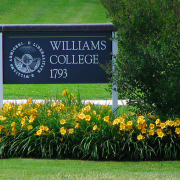When presented as a brand, the university becomes just another conduit for the money-centered shallowness that seems to characterize much of modern American society.
In a recent article in the Wall Street Journal (posted on FutureU, August 13), Melissa Korn, Andrea Fuller, and Jennifer Forsyth note the staggering spending spree public universities have been on in recent years. Many campuses have seen new buildings popping up like mushrooms and old buildings torn down to be replaced with lavish modern gems.
It seems the goal of many university administrators these days is to create palatial campuses, often with absurdly expansive and expensive athletic facilities–even if, in some cases, it generates budget deficits and layoffs. At times, the excess is breathtaking. A few years ago, the University of Oklahoma spent millions to purchase and renovate an Italian monastery for study abroad programs while increasing tuition at the same time.
Nice campuses are…nice. But are they necessary? Indeed, there is value in having good facilities, but there is a difference between facilities that do the job and those that are opulent.
I remember one building I entered on a flagship public university campus a few years ago. During a break in the teaching seminar, I headed to the men’s room, where I found the stalls a touch beyond the usual functional metal—they were made of very thick, beautiful hardwood that must have been quite expensive.
I will admit that I don’t see the value in deluxe bathroom stalls on a college campus. Granted, it was in the business school, so perhaps the designers were channeling the overall neoliberal zeitgeist of greed and excess one finds in such places. Maybe it was an attempt at architectural sarcasm.
The quest by university administrators to create academic resorts is a product of the short-sighted and misdirected neoliberal over-emphasis on branding and competition. In the endless goal of pitching their campus to students, administrators focus on outward appearances and the things they think will sell—like rock climbing walls in the student union—instead of emphasizing values associated with learning.
They’ll tell students, “We have a world-class faculty,” because they think anything with the words “world-class” sells. It seems every university these days has a “world-class faculty.” But the truly important issue is whether the university is a good fit for particular students and how it will make them better citizens.
But both seem low on the priority list these days. Rock climbing walls sell; values don’t.
How universities are sold these days reminds me of how sports cars were sold in the 1960s. Along with the bragging about displacement and zero-to-sixty time, there was almost always an appeal to sex. The purpose was to get men to buy the car. It didn’t matter if the car they were buying was any good, and it was largely irrelevant if it was safe.
Rather than presenting what a particular university is good at or what it can do for its students, today’s goal is to promote and merchandise to prospective students. My daughter, who is a high school senior, gets daily ads from all sorts of colleges and universities that try to sell her on how great the campus is or how “world-class” a faculty she will encounter if she chooses said school.
Administrators, it would seem, are bent upon competing for students by selling their “brand” as luxurious and appealing. This shows one of the problems of having a vast cadre of administrative staff at universities who do not come from the teaching faculty.
They have an entirely different agenda from the university’s core mission of teaching and research because they are not educators. The agenda is sales, and I can think of few things more contrary to the purpose and mission of a university. Indeed, the values this approach conveys to students and society are superficiality, competition, and greed. When presented as a brand, the university becomes just another conduit for the money-centered shallowness that characterizes much of modern American society.
Higher education administrators must reflect on this and ask important questions: How do fancy facilities support education and research? Does the emphasis on branding devalue the educational and research mission of the university? And, perhaps, the most important question of all: Does “branding” help to support the primary purpose of public higher education, which is to contribute to and promote the public good?
If you ask most students about what matters most, the cost of tuition or the elegance of buildings on campus, the answer will be tuition. Maybe wealthy students will be more concerned with how fancy the facilities are (although I am not convinced they will), but those students with limited means will not.
And this points to how many public universities have lost their direction. The primary mission of a public university is not to compete for students. It is to serve the needs of the populace at a reasonable cost so that everyone has the opportunity to access quality higher education, should they want that, without severe financial limitations inhibiting that goal or creating a major burden for their futures.
It’s time for public university administrators to stop trying to hawk their institutions with branding and lavish facilities. Instead, they need to focus on ensuring that their institutions serve the public, are affordable, and, in so doing, are attractive to those who wish to learn and contribute to society.
Focusing on frugality rather than opulence would be a good place to start.
________
The cover graphic is courtesy of Medium.



